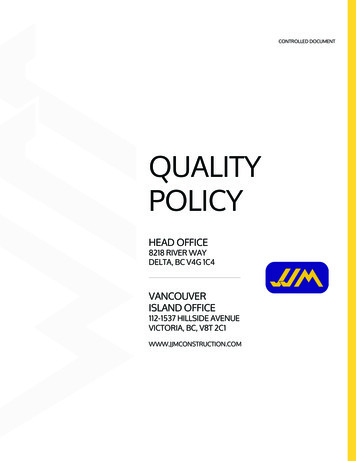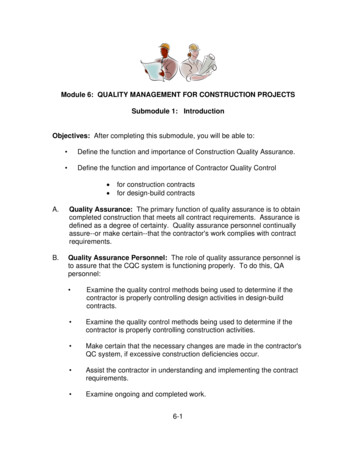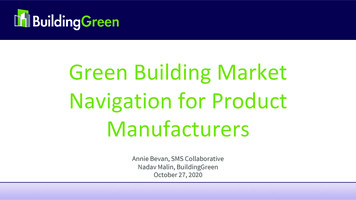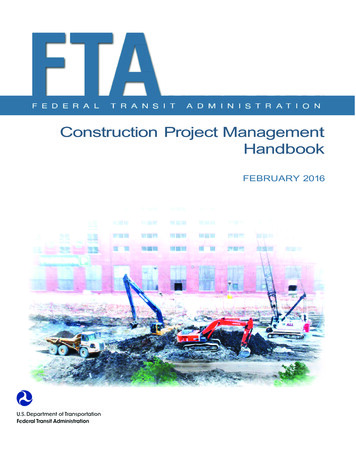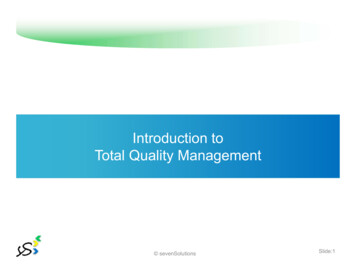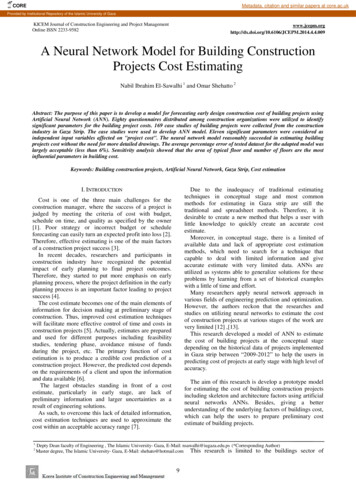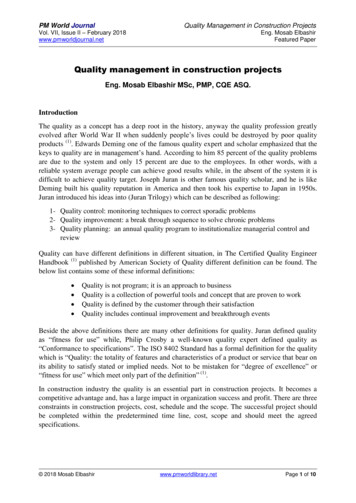
Transcription
PM World JournalQuality Management in Construction ProjectsVol. VII, Issue II – February 2018www.pmworldjournal.netEng. Mosab ElbashirFeatured PaperQuality management in construction projectsEng. Mosab Elbashir MSc, PMP, CQE ASQ.IntroductionThe quality as a concept has a deep root in the history, anyway the quality profession greatlyevolved after World War II when suddenly people’s lives could be destroyed by poor qualityproducts (1). Edwards Deming one of the famous quality expert and scholar emphasized that thekeys to quality are in management’s hand. According to him 85 percent of the quality problemsare due to the system and only 15 percent are due to the employees. In other words, with areliable system average people can achieve good results while, in the absent of the system it isdifficult to achieve quality target. Joseph Juran is other famous quality scholar, and he is likeDeming built his quality reputation in America and then took his expertise to Japan in 1950s.Juran introduced his ideas into (Juran Trilogy) which can be described as following:1- Quality control: monitoring techniques to correct sporadic problems2- Quality improvement: a break through sequence to solve chronic problems3- Quality planning: an annual quality program to institutionalize managerial control andreviewQuality can have different definitions in different situation, in The Certified Quality EngineerHandbook (1) published by American Society of Quality different definition can be found. Thebelow list contains some of these informal definitions: Quality is not program; it is an approach to businessQuality is a collection of powerful tools and concept that are proven to workQuality is defined by the customer through their satisfactionQuality includes continual improvement and breakthrough eventsBeside the above definitions there are many other definitions for quality. Juran defined qualityas “fitness for use” while, Philip Crosby a well-known quality expert defined quality as“Conformance to specifications”. The ISO 8402 Standard has a formal definition for the qualitywhich is “Quality: the totality of features and characteristics of a product or service that bear onits ability to satisfy stated or implied needs. Not to be mistaken for “degree of excellence” or“fitness for use” which meet only part of the definition” (1).In construction industry the quality is an essential part in construction projects. It becomes acompetitive advantage and, has a large impact in organization success and profit. There are threeconstraints in construction projects, cost, schedule and the scope. The successful project shouldbe completed within the predetermined time line, cost, scope and should meet the agreedspecifications. 2018 Mosab Elbashirwww.pmworldlibrary.netPage 1 of 10
PM World JournalQuality Management in Construction ProjectsVol. VII, Issue II – February 2018www.pmworldjournal.netEng. Mosab ElbashirFeatured PaperQuality ManagementThe American society of quality (ASQ) glossary defines quality management as “the applicationof quality management in managing a process to achieve maximum customer satisfaction at thelowest overall cost to the organization while continuing to improve the process” (2).Quality management is one of the knowledge area in the project management body ofknowledge guide (3). It includes “all processes and activities of the performing organization thatdetermine quality polices, objectives and responsibilities so that the project will satisfy the needsof which it was undertaken”.Figure 1 illustrate the total quality system process; it shows that the quality is everybodyresponsibility in the organization (2).Figure 1: Total quality system (Adopted from Abdul Razzak Rumane, Quality Management inConstruction Projects 2011)Quality CostIn construction projects, quality is defined and associated with project scope, Cost and time.Cost of quality refer to “the total cost incurred during the entire life cycle of construction projectin preventing nonconformance to owner requirement” (2). The project budget is fixed there for; itis important to avoid variation during the construction process. It is very difficult to get approvalfor variation during the project execution, and it is important to avoid such case. Quality costrelated to construction project can be summarized as follow (2): 2018 Mosab Elbashirwww.pmworldlibrary.netPage 2 of 10
PM World JournalQuality Management in Construction ProjectsVol. VII, Issue II – February 2018www.pmworldjournal.netEng. Mosab ElbashirFeatured PaperInternal failure cost ReworkRectificationRejection of check listCorrective actionExternal failure cost Breakdown of installed systemRepairMaintenanceWarrantyAppraisal cost Design review/preparation of shop drawingsPreparation of composite/coordination drawingsOnsite material inspection/testOffsite material inspection/testPre-checklist inspectionPrevention cost Preventive actionTrainingWork proceduresMethod statementsCalibration of instruments/equipmentQuality PlanningProject management body of knowledge guide (3) defines quality planning as the process ofidentifying quality requirements and/or standards for the projects and its deliverables anddocumenting how the project will demonstrate compliance with quality requirements. It is veryimportant to plan all the quality activities during the project planning phase to avoid anydiscrepancies latter in the project. The PMBOK (3) identifies the below tool & techniques forquality planning: Cost-benefit analysisCost of qualityBenchmarkingSeven basic quality toolsDesign of experimentMeeting 2018 Mosab Elbashirwww.pmworldlibrary.netPage 3 of 10
PM World JournalQuality Management in Construction ProjectsVol. VII, Issue II – February 2018www.pmworldjournal.netEng. Mosab ElbashirFeatured PaperThe most important output of the quality planning is the quality management plan.Peter Fewings (4) defines the quality planning process as a strategy to meet client requirementsand expectation and should address service quality as well as product quality.Quality ControlPMBOK (3) describes quality control as the process of monitoring and recording results ofexecuting the quality activities to assess performance and recommend necessary changes. TheAmerican society of quality (ASQ) termed quality control as process orientation that consist ofproduct inspection and statistical quality control (2). PMBOK identifies the following tools &techniques for quality control: InspectionControl chartsPareto diagramsStatistical samplingFlowchartingScatter diagramCause & effect diagramHistogramsCheck sheetsThe following activities consider as a sample of quality control activities in constructionprojects: Inspection of steel and form work for concrete membersField density tests for soilSlump tests for concreteCrushing tests for concreteEarn value reports (Control schedule by schedule index and control cost by cost index)Flood testThe quality control activities are crucial to monitor and control the execution of the project.Failing to perform these activities has a catastrophic impact on the project.Quality AssurancePMBOK (3) defines quality assurance as the process of auditing the quality requirements and theresults from the quality control measurements to ensure that appropriate quality standards andoperational definitions are used. The tools and techniques for quality assurance are:1- Quality management & control tools2- Quality audits3- Process analysis 2018 Mosab Elbashirwww.pmworldlibrary.netPage 4 of 10
PM World JournalQuality Management in Construction ProjectsVol. VII, Issue II – February 2018www.pmworldjournal.netEng. Mosab ElbashirFeatured PaperThe American society of quality (ASQ) defines quality assurance as “all planned and systematicactivities implemented within the quality system that can be demonstrated to provide confidencea product or a service will fulfill requirements of quality” (2). Quality assurance in constructionprojects is the cover all activities performed by the design team, contractor, quality controllerand consultant (supervision staff) to meet client’s objectives as specified and to ensure that theproject/ facility is fully functional to the satisfaction of the client/ end users. (2)Documentation & RecordsDocumentation is an essential part of any quality system. Documentation components includequality polices, quality procedures, quality records, contract documents etc. The project willnot be closed unless all the paper work is completed. The author compiled the below list as asample of the documents that should be available and maintain at the project site. The contractorshould store and handle these documents in a proper way to retrieve them upon request. Thedocuments are: Contract documents, agreement and project technical specificationsOverall project scheduleApproved drawingsQA/QC planHSE planMethod of statementsRequest for inspections (RFI) & Request for material inspections (RMI)Tests recordsMarked up drawingsConcrete pouring formsFactory acceptance tests (FAT) reportsInspection test plan (ITP)Site instructionsCalibration certificateApproved material vendor listVendor drawingsProject organization chartLog sheet for all the documents (tests records, RFIs &RMIs, drawings, siteinstructions etc.)All the above documents should be updated and configured in a proper way.Quality ImprovementContinuous improvement is a key factor to reduce quality cost and a key factor of qualityimprovement is a corrective action. Quality improvement is achieved by continuously improvingthe production and business process of an organization. It is optimized by (1): Viewing all work as process, whether it is associated with production or process 2018 Mosab Elbashirwww.pmworldlibrary.netPage 5 of 10
PM World JournalQuality Management in Construction ProjectsVol. VII, Issue II – February 2018www.pmworldjournal.net Eng. Mosab ElbashirFeatured PaperMaking all processes effective, efficient, and adaptableAnticipating change in customer needControlling in-process performance using metrics such as scrap and cycle time, andmonitoring tools such as control chartMaintaining constructive dissatisfaction with the present level of performanceEliminating waste and rework wherever it occursInvestigating activities that do not add value to the product or service, with the aim toeliminate those activitiesEliminating nonconformities in all phases of everyone’s work, even if the increment ofimprovement is smallUsing benchmarking to improve competitive advantageInnovating to achieve breakthroughHolding gains so there is no regressionIncorporating lesson learned into future activitiesUsing technical tools such as statistical process control (SPC), experimental design,benchmarking, and so onIn the fixed price construction contract the schedule is the most important constraint for theclient. The author proposes the below procedure to identify the most common reasons behindproject’s delay. The same procedure can be used for the other constraint (Cost and Scope). Thisprocedure is a sample of one of the continuous improvement methods to identify, analyze, andeliminate the defects. The procedure is as follow:1- Designing a survey form as can be seen in figure 22- Sending the survey form to the stakeholders, who involve in the projects management inthe organization3- The Participant should fill in the form, mentioning the causes of the projects delay andhow to eliminate the causes from their point of view4- The collected data should be analyzed to figure out the most common reasons of delay. Itis possible to use Pareto chart (See figure 3) to visualize and analyze the data5- The final step is to figure out how to eliminate or mitigate the most common problemsbehind projects delayNo.Causes of delay in projectsSuggestion to avoidthe delayDiscipline (Civil,Elect.Mech., .etc.)1234567Figure 2: Survey form. 2018 Mosab Elbashirwww.pmworldlibrary.netPage 6 of 10
PM World JournalQuality Management in Construction ProjectsVol. VII, Issue II – February 2018www.pmworldjournal.netEng. Mosab ElbashirFeatured Paper70%60%% Occurrence50%40%30%20%10%0%Man powerDesign approvalMaterialDeliveryPlaning issues Site conditionsFigure 3: Sample of reasons can cause project’s delay.Quality Improvement BarriersThe certified quality engineer handbook (1) identifies 12 obstacles to implement quality. Theobstacles or barriers and how to overcome them are listed below: Lack of time to devote quality initiativesSenior management must provide time for employees to devote to quality initiative, oncethe system is established, the quality activities will become part of the employee’sroutine. Poor intra-organizational communicationOrganization must encourage and provide the means of two-way communication so thatthe information flows up as well as down the ladder. Lack of real employee empowermentIndividuals should be empowered to take decisions that affect the efficiency of theirprocess or the satisfaction of their customers. Training is necessary to provideconfidence. Lack of employee trust in senior managementIt is important that the senior management to be honest with employee. It is themanagement responsibility to create an environment of trust. Politics and turf issueThe use of multifunctional teams will help resolve the differences between departmentand individuals. Restructuring the organization to be more responsive to customer needis necessary. 2018 Mosab Elbashirwww.pmworldlibrary.netPage 7 of 10
PM World JournalQuality Management in Construction ProjectsVol. VII, Issue II – February 2018www.pmworldjournal.net Eng. Mosab ElbashirFeatured PaperLack of formalized strategic plan for changePeople normally resist change. The management should understand and utilize this basicconcept of change:1. People change when they want to meet their own needs2. Never expect anyone to engage in behavior that services the organization’s valuesunless an adequate reason has been given3. For change to be accepted, people must be moved from a state of fear to trustHonest two-way communication with respectful feedback increases the chances ofsuccess. Lack of strong motivationIt is the management’s responsibility to create a conductive environment for individualsto become motivated. View of quality program as a quick fixQuality improvement is a journey not a destination. Management should support thecontinuous improvement so that quality and productivity are continually andpermanently improved and costs reduced. Drive for short-term financial resultsQuality improvement requires an organization to have a strong future orientation and awillingness to make long-term commitment. Lack of leadershipLeadership is essential for organization success. Leadership requires commitment interms of both management time and organization resources. Lack of customer focusOrganization need to meet the expectation of the internal and external customers.Effective feedback mechanisms are required for this purpose. Lack of companywide definition of qualityExperienced quality professionals recommend that all areas of the organizations beinvolved in writing the definition.Conclusion Quality is a culture an attitude, without the commitment and support of the topmanagement of the organization, no quality program is going to success No matter how qualified resources the organization has, without quality system theoutput will always be poor 2018 Mosab Elbashirwww.pmworldlibrary.netPage 8 of 10
PM World JournalQuality Management in Construction ProjectsVol. VII, Issue II – February 2018www.pmworldjournal.netEng. Mosab ElbashirFeatured Paper Quality has two aspects, processes documentation quality and products quality. Quality planning, quality assurance and quality control are an essential component of thequality system. Quality in the construction projects is a business need and a competitive advantage. Continuous improvement is a key factor to sustain the quality system. Senior management hold the responsibility to overcome the quality barriers.References(1)Connie M.Borror, Editor. Certified Quality Engineer Handbook. American Society ofQuality, Quality Press, Milwaukee 53203, 2009.(2)Abdul Razzak Rummane. Quality Management in Construction Projects. CRC Press,Taylor & Francis Group, 2011.(3)Project Management Institute, PMI. A Guide to The Project Management Body ofKnowledge (PMBOK). Fifth Edition. Project Management Institute Inc., 2013.(4)Peter Fewings. Construction Project Management. Taylor & Francis, 2005. 2018 Mosab Elbashirwww.pmworldlibrary.netPage 9 of 10
PM World JournalQuality Management in Construction ProjectsVol. VII, Issue II – February 2018www.pmworldjournal.netEng. Mosab ElbashirFeatured PaperAbout the AuthorEng. Mosab ElbashirSudan - Saudi ArabiaEng. Mosab Elbashir Msc, PMP, CQE ASQ, Construction projects management expertwith 15 years of experience. Graduated from University of Khartoum (Sudan), faculty ofengineering, civil engineering department in 2003 (BSc). Mosab, obtained his Masterdegree from Lund University (Sweden) in Water Resources in 2007. Certified qualityengineer from American Society of Quality (CQE ASQ) and project managementprofessional (PMP –PMI). Currently works as a consultant with The Saudi ElectricityCompany in Saudi Arabia since 2012. Interested in projects control and qualitymanagement. For more information, please 595a64/Email: mosab 555@hotmail.com 2018 Mosab Elbashirwww.pmworldlibrary.netPage 10 of 10
Figure 1 illustrate the total quality system process; it shows that the quality is everybody responsibility in the organization (2). Figure 1: Total quality system (Adopted from Abdul Razzak Rumane, Quality Management in Construction Projects 2011) Quality Cost In construction projects, quality

